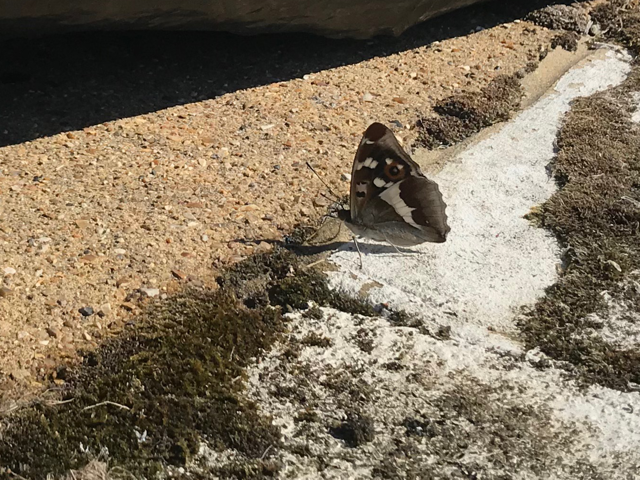The new queen
My last blog was posted in the summer when we’d introduced a new queen bee to our hive. We had to wait a few weeks to discover if the workers had accepted the queen . . . or killed her!
So we lit our smoker, pulled on our suits and were very pleased to find that the new queen had indeed been accepted. We couldn’t actually see her, but there was plenty of brood (baby bees) and this was proof enough that she was busy laying eggs and keeping the hive alive.

Our last check inside the hive was three weeks ago and things were looking good. Once again, we couldn’t actually spot the queen but there was brood and the workers had been busy building up their honey supplies for the winter. The frames were heavy with the sticky stuff!
Due to the setback of losing our original queen, we have decided not to take any honey this year. Our bees have worked hard to build the colony up again and we want to give them every chance of surviving the winter.
Butterflies
The hot summer seems, at least down our lane, to have been good for insects. My bee-keeping neighbour and I have been keeping a close eye on the butterflies appearing in our lane. As ever, we have seen lots of white butterflies and meadow browns but speckled woods have also done well . . .

. . . along with common blues and small skippers. Red admirals, peacocks and commas were also spotted but less often. One other interesting observation was a flurry of marbled whites around my neighbour’s top bar hives (see next blog for top bar hive info!). The top bar hives sit in a smallish square of ground fenced off from the sheep. This is the only place we saw marbled whites and for a week or so they were abundant. We couldn’t work out what the sheep might have been eating outside the fenced top bar patch that meant the marbled whites were only happy inside. Intriguing! My best spot of the summer was a white admiral in Saint Leonard’s Forest, 5 miles from our lane. Not a brilliant photo but I chased it for quite a while before it settled.

But my neighbour totally topped this with the purple emperor she spotted by the pool.

But it’s not just butterflies who have enjoyed the long hot summer . . .
Wasps!
We keep a dish of water by our hive. I put it there for our bees but it quickly became a favourite watering hole for the dreaded wasps!

Unlike bees, wasps don’t live through the winter. Only the queen wasp survives. She hibernates through the cold months emerging in the spring to start a new nest and continue the cycle of life. In the spring, wasps are actually a gardener’s friend. They kill cabbage-munchers such as aphids and caterpillars and feed them to their young. It is in late summer when all work in the nest has been done (the queen has stopped laying eggs) and there is no food for the wasps, that they hunt elsewhere for nutrition. They will die anyway before winter sets in but will angrily scavenge any sweetness they can before they drop!
As a novice beekeeper, I was horrified to spot wasps buzzing around the hive and picking off bees near the entrance. Their main aim is to get inside and gorge on honey but they will also attack and even behead honeybees . . .
Something had to be done and, once again, Youtube helped out. Wasp traps, I discovered, are easy to make and very effective! A plastic water bottle cut in half with the top inverted and an inch of cola or ginger beer at the bottom, creates a clever collecting and killing device.
I placed this trap by the hive and not a single bee was lured inside. They have a superior stock of sweetness indoors and don’t need to binge on cheap fizzy drinks. I don’t take pleasure in killing any living creature but, as mentioned, these wasps have done their work and are destined to die before winter so if I can stop them from attacking my bees and stealing their honey, I will!
It’s possible the wasps got their revenge, anyway . . .
It was while I was having a cup of tea and watching my hive (perhaps a little too closely) that I was stung on the face. I’m not sure if it was a bee or a wasp but it was painful. I thought nothing more of it until I awoke the following morning with only one eye working.

Eek! I Googled to see if other bee-keepers has suffered similar injuries and was pleased to read that yes, eyes puff up and even close for a day or two but after a week the face returns to normal. Mum dug out a photo of Dad who, like me, had been a bit casual about his protection around their hive. Here’s Dad, circa 1986.

As well as enjoying our bees, I have been busy promoting my second Bee Boy book which was published in August. My Bee Boy trilogy is aimed at 7 to 12 year olds and published by Oxford University Press. The books are fiction but based around the real life of bees. Book 2 is all about dangerous insecticides and what happens to bees that feed from plants that have been sprayed . . .
But back in the real world, our bees have survived their first summer and our next job is to prepare for the coming winter. They say it’s going to be a cold one!


Great blog! Look me up at Ward Bros. Honey Co. if you want, I went ahead and followed you cause us beekeepers need to stick together, right?
LikeLike